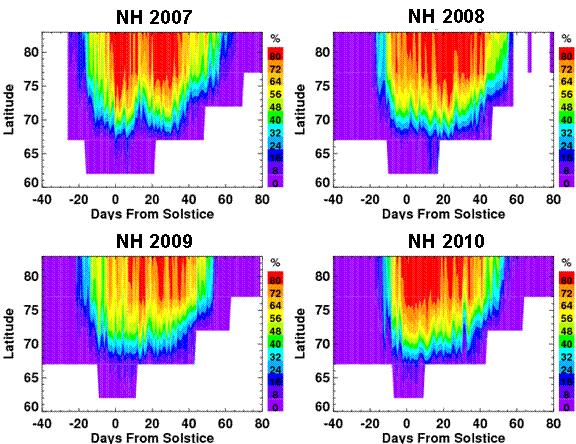|
STATUS:
10.01.10
Spacecraft Status
AIM continues to operate nominally. On September 23, the on-board autonomy process switched to Southern Hemisphere imaging for CIPS in preparation for the upcoming PMC season. We also had a brief period of bitlock on September 25.
Instrument Status
SOFIE continues to operate nominally. All status flags remain GREEN, and all engineering parameters are well within tolerance.
SOFIE PMC measurements have been used to evaluate particle size with the new band 2 UV observations taken since November 2009. Using V1.022, effective radii based on the UV observations were systematically smaller than radii obtained using the NIR measurements (the standard approach). Using the new V1.03 retrievals, this UV - NIR particle discrepancy is nearly absent. This change is attributed to the improved treatment of FOV and RSR, in addition to improved signal conditioning, in V1.03.
The SOFIE UV - IR PMC spectra has been found to be consistent with a mixture of ice and meteoric smoke. This result has implications for interpreting the measurements to determine particle size, but more importantly is the first direct evidence that mesospheric ice particles nucleate on meteoric smoke.
We are beginning to reprocess the entire data set with the V1.03 software after including a couple of minor improvements to the development tree. The data will be validated before the next AIM science team meeting and released to the public shortly afterward.
CIPS continues to operate nominally. The operational version 3.21 data for the NH 2010 season have now been reprocessed with the full calibration data set, which contains calibration observations from March, April, June, July and August. The figure below shows the CIPS PMC frequencies for ascending node data in all of the NH seasons thus far observed by AIM. There is significant variability from season to season and throughout each season. Correlating these variations with changes in temperature and water vapor is the subject of ongoing research. All of the data are available on the AIM web site.
Development of the next retrieval version, v4.20, is continuing. We have made significant improvements to the algorithm in the last few weeks. This includes implementing a robust method for detecting clouds that takes into account variations in CIPS sensitivity based on solar zenith angle and view angle. Many test orbits in each season have been processed multiple times with the developmental v4.20 algorithm, as we find and fix small bugs in the codes. Because these tests have taken longer than anticipated, the release of v4.20 has been delayed into October. Finally, we are still in the process of designing calibration observations for implementation in autonomy.

|
